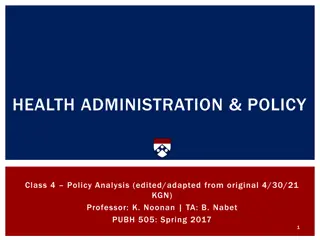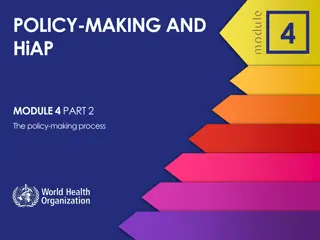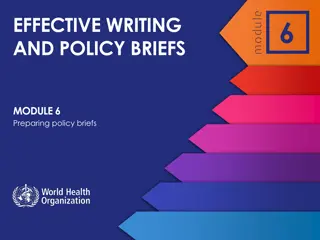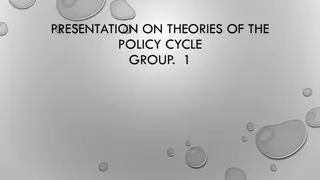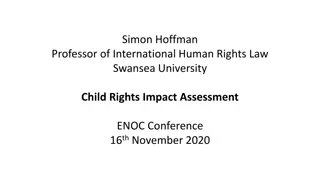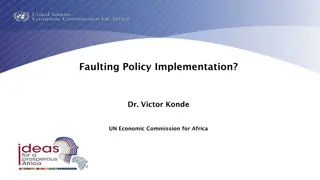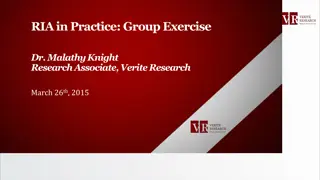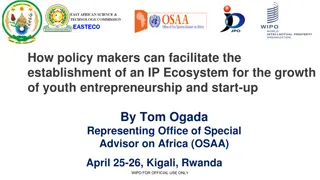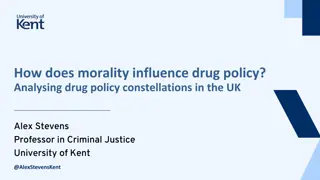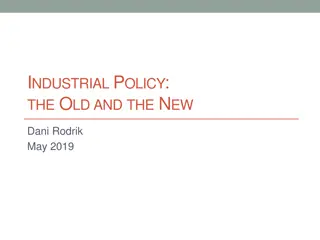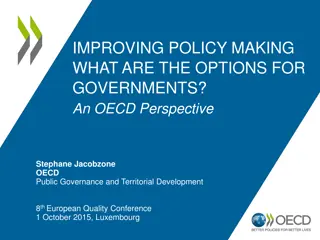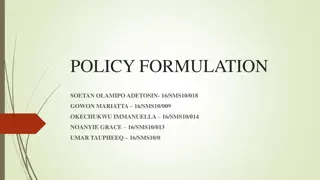Policy Making Process
A policy is a set of ideas or plans that serve as a basis for decision-making. It reflects an organization's attitude and actions towards a specific issue, offering a guiding statement for decision-making. More than just setting goals, policies delve into how goals can be achieved, who will implement tasks, and in what manner. The four stages of the policy process include problem identification, policy formulation, implementation, and evaluation. In the health sector, various policies like National Health Policy, Nutrition Policy, Women Policy, Training Policy, and Population Policy are devised to address specific concerns. Population policy, for instance, involves measures by social institutions and governments to influence population size, distribution, and composition. The National Population Policy in India has witnessed milestones over the years, aligning efforts to manage the country's population growth.
Download Presentation

Please find below an Image/Link to download the presentation.
The content on the website is provided AS IS for your information and personal use only. It may not be sold, licensed, or shared on other websites without obtaining consent from the author.If you encounter any issues during the download, it is possible that the publisher has removed the file from their server.
You are allowed to download the files provided on this website for personal or commercial use, subject to the condition that they are used lawfully. All files are the property of their respective owners.
The content on the website is provided AS IS for your information and personal use only. It may not be sold, licensed, or shared on other websites without obtaining consent from the author.
E N D
Presentation Transcript
What is a Policy? Set of Ideas or Plans that is used as a basis for decision making; Attitude and actions of an organization regarding a particular issue; General Statement of understanding which guide decision making.
Cont.. It is more than mere statement of goals: How the stated goals can be achieved? Who will carry out the tasks? In what manner?
Four stages of Policy Process Problem Identification and Issue Recognition Policy Formulation Policy Implementation Policy Evaluation
Policies related to Health Sector National Health Policy Nutrition Policy Women Policy Training Policy Population Policy
What is Population Policy? Measures formulated by a range of social institutions including Government which may influence the size, distribution or composition of human population (Driver,1972). A deliberate effort by a national government to influence the demographic variables like fertility, mortality and migration (Organski & Organski,1961) A set of Coordinated laws aimed at reaching some demographic goal (Biurgeois-Pichat,1974
NATIONAL POPULATION POLICY AND NATIONAL POPULATION PROGRAMME
Introduction 2000 India Projected 1 Billion People on 2.4% of Globe s Land Area India's current annual increase in population of 15.5 million is large enough to neutralize efforts to conserve the resource endowment and environment.
National Population Policy - Milestones 1946- Bhore Committee Report 1952- Family Planning Programme 1976- Statement of National Population Policy 1977- Policy Statement of Family Welfare Programme
Cont 1983- National Health Policy emphasized the need 1991- National Development Council appointed a Committee 1993- Dr. Swaminathan group prepared a Draft and discussed by cabinet and then Parliament
Cont.. 1991- Circulated and requested comments from Central and State Agencies 1997- Promised to announce this policy in near future 1999- Another Draft Policy was finished and finalized it on 19th Nov.
Population Growth, Crude Birth And Death Rates And Sex Ratio: India Year Population in Million % Average annual exponenti al growth rate(%) - Crude birth rate Crude Death Rate Sex Ratio (Females per 1000 Males) Decadal Variation 1901 238.4 - 45.8 44.4 972 1951 361.1 13.31 (+1)1.25 39.9 27.4 946 2001 1028.6 21.54 (+1)1.95 24.8 8.9 933
Population Projection- Ministry of Health and Family Welfare
Objectives Immediate Objective To address the unmet needs for contraception, health care infrastructure and health personnel and to provide integrated service delivery for basic reproductive and child health care.
Cont.. Medium- term Objective To bring the TFR to replacement level by 2010, through vigorous implication of inter-sectorial operational strategies.
Cont.. Long term Objective To achieve a stable population by 2045, at a level consistent with the requirements of sustainable economic growth, social development and environmental protection.
Programmes implemented to achieve immediate goal and medium term goal Aims up to 2010 IMR below 30/1,000 live births MMR below 100/1,00,000 live births 80% institutional deliveries 100% registration of vital events Medium Term Goal Total fertility Rate to replacement level
Cont.. Themes to achieve these Objectives Decentralized planning and implementation Convergence of service delivery at the Grassroots Empowering women and encouraging male involvement
Cont Meeting the unmet need for family Welfare Services Addressing the needs of disadvantaged and under- served population groups Encouraging public- private partnership
Health Care Infrastructure Public Sector District CHC (4 PHC) PHC-(Referral Unit for 6 Sub-Centers) Sub center
Cont.. Population Distribution Hilly- 5000 Plains- 3000 Sub center Hilly- 30,000 Plains- 20,000 PHC Hilly- 1,20,000 Plains- 80,000 CHC
Cont.. Informal Not for Profit Indigenous Private Sector For Profit Formal
Health Care Reforms and its implications for Reproductive Health Public Private Partnership E.g. Pharmacies, Laboratory, $ Blood bank
Programmes will plan to implement in coming days Revised national population policy aimed at improving quality of life in the country. - Daily Times on 6thApril 2010 The revised policy focusing on improving health, managing urbanization and gender-sensitive development.
Population Policy National Population Policy
Cont National Commission on Population Formulated on 11thMay 2000 Reconstituted on Feb 2005 Members Chairman Deputy Chairman 2 vice Chairman Secretary
Cont.. Aims To review, monitor and give directions for the implementation of the National Population Policy To promote synergy between demographic, educational, environmental and developmental programmes. To promote intersectoral co-ordination in planning and implementation. First Meeting-23rdJuly 2005- Survey of all District to identify the weakness in Health Care Delivery System.
Cont State Population Commission Janasankhya Sthirata Kosh Objective To facilitate goal, support projects, schemes, initiatives and to introduce innovative ideas, both in government and voluntary sectors.
Cont. Family Planning Programme Family Planning Performance Sterilization Vasectomy and Tubectomy IUD Insertion Condom Users $OP users
All India Family Planning Acceptors Year Sterilizatio n IUD Insertion Equivale nt CC users Equivale nt OP users 1980-81 2053 628 3718 91 2000-01 4,735 6,047 18,204 7,640 2007-08 5,019 6,072 26,799 10,893
Cont National Rural Health Mission Pre Conception and Pre Natal Diagnostic Techniques (Prohibition of sex selection) Act, 1994
Population Programmes/Schemes Basic infrastructure -Sub Centre (1,46,036) -PHC (23,458) -CHC (4,276)
Cont. Janani Suraksha Yojana Family Welfare Linked Health Insurance Scheme Compensation for acceptor of Sterilization
POPULATION RESEARCH CENTER
Current Datas- Infant Mortality Rate
http://www.indiareport.com/resources/images/newsimages/Ghulam%20Nabi.jpghttp://www.indiareport.com/resources/images/newsimages/Ghulam%20Nabi.jpg Cont January 12, 2011 "In spite of the achievements made so far there are still areas of concern. The pace of decline in various key health indicators like IMR, MMR, Total Fertility Rate and death and morbidity due to communicable diseases has not improved as compared to pre-NRHM period,"Azad said.
Journal Abstract Title : Family Planning in India: Approaches and achievements. Author: Haruno Sagaza and Alok Kumar
Cont.. Findings: Collaborative efforts at micro and macro levels be made inorder to achieve the demographic goals established by the central and state Gov, thus reducing the population growth rate and enhancing the standards of living
Theory Application Ludwing Von Bertalanffy: General System Theory




